Cross-Cultural Management Report: Analyzing Leadership and Ethics
VerifiedAdded on 2023/01/09
|11
|3145
|100
Report
AI Summary
This report provides a comprehensive analysis of cross-cultural management, examining the challenges and opportunities faced by organizations operating in diverse cultural contexts. The report begins with an introduction to cross-cultural management, highlighting its importance in today's globalized world, and then presents a case study of HydroGeneration (HG), a US-based company undertaking a dam construction project in Tanzania. The main body of the report delves into key topics such as national culture, leadership theories (situational, system, and contingency), and ethical considerations, including corporate social responsibility (CSR). It explores the impact of cultural differences on organizational behavior, recruitment practices, and business operations, using Hofstede's cultural dimensions to compare the cultures of Tanzania and the US. The report analyzes the leadership approaches needed to address cross-cultural conflicts and ethical dilemmas, and it concludes with recommendations for effective cross-cultural management strategies. The analysis emphasizes the importance of understanding cultural nuances, adapting leadership styles, and maintaining ethical standards to achieve successful business outcomes in international settings. The report also highlights the significance of interpersonal skills and the application of management techniques in navigating cross-cultural problems.

CROSS CULTURAL
MANAGEMENT
MANAGEMENT
Paraphrase This Document
Need a fresh take? Get an instant paraphrase of this document with our AI Paraphraser
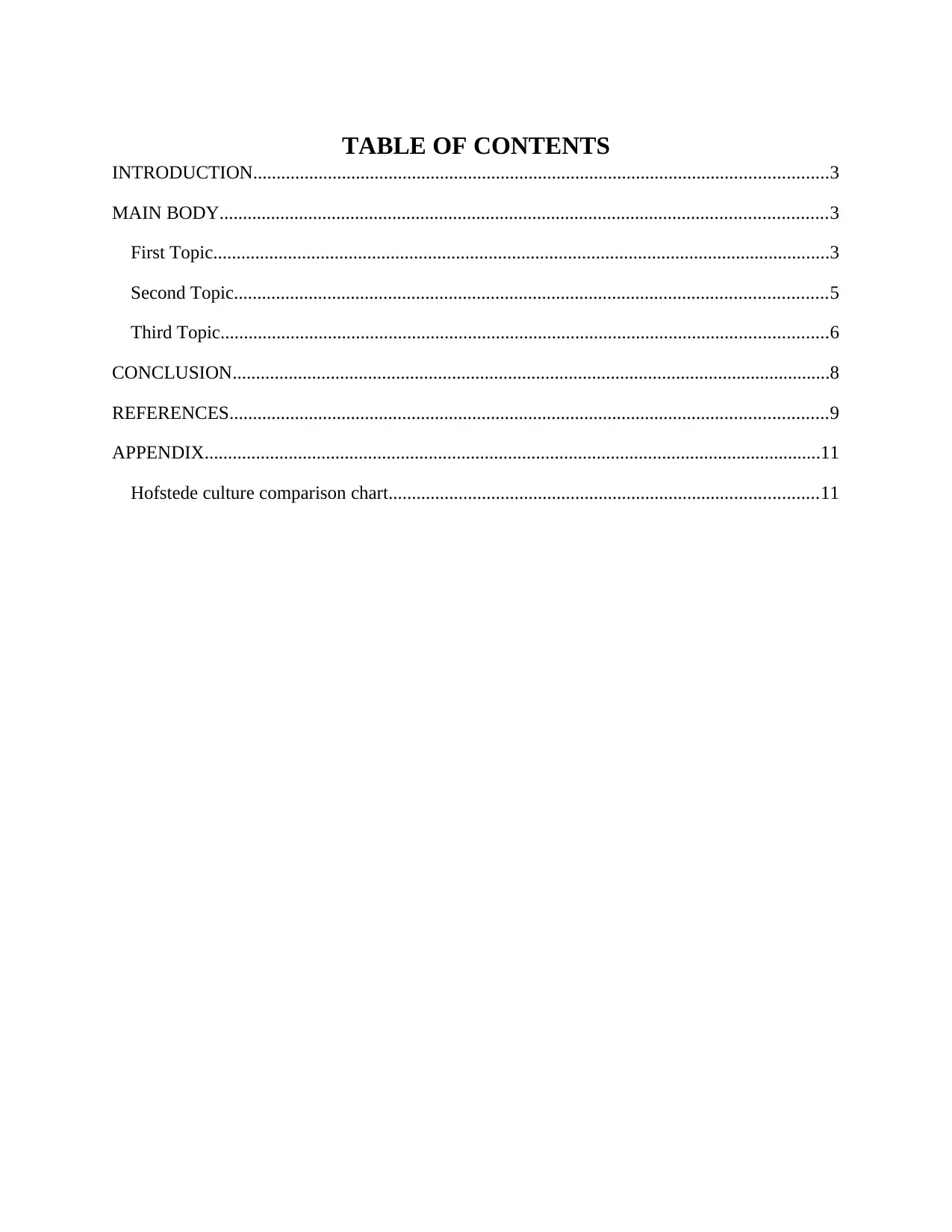
TABLE OF CONTENTS
INTRODUCTION...........................................................................................................................3
MAIN BODY..................................................................................................................................3
First Topic....................................................................................................................................3
Second Topic...............................................................................................................................5
Third Topic..................................................................................................................................6
CONCLUSION................................................................................................................................8
REFERENCES................................................................................................................................9
APPENDIX....................................................................................................................................11
Hofstede culture comparison chart............................................................................................11
INTRODUCTION...........................................................................................................................3
MAIN BODY..................................................................................................................................3
First Topic....................................................................................................................................3
Second Topic...............................................................................................................................5
Third Topic..................................................................................................................................6
CONCLUSION................................................................................................................................8
REFERENCES................................................................................................................................9
APPENDIX....................................................................................................................................11
Hofstede culture comparison chart............................................................................................11
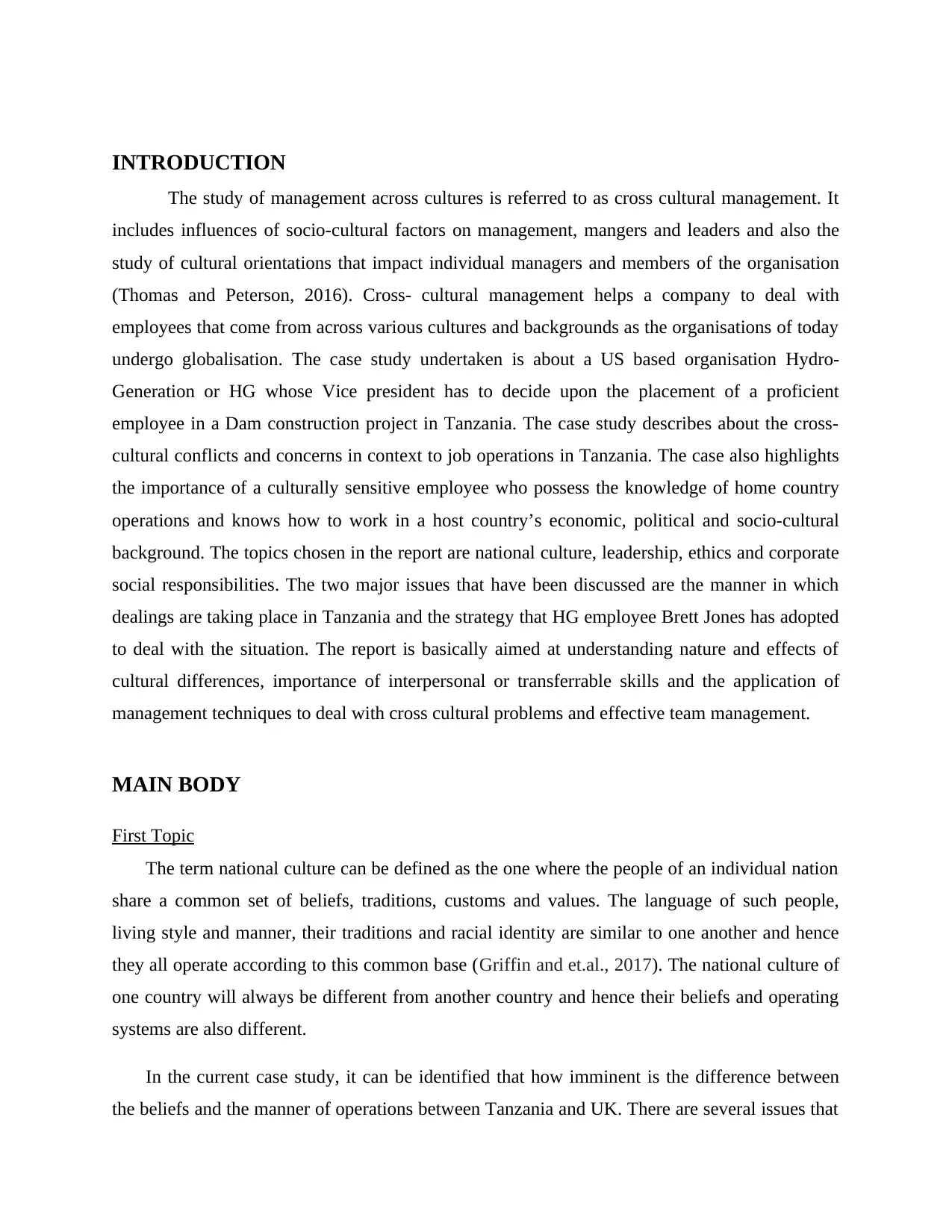
INTRODUCTION
The study of management across cultures is referred to as cross cultural management. It
includes influences of socio-cultural factors on management, mangers and leaders and also the
study of cultural orientations that impact individual managers and members of the organisation
(Thomas and Peterson, 2016). Cross- cultural management helps a company to deal with
employees that come from across various cultures and backgrounds as the organisations of today
undergo globalisation. The case study undertaken is about a US based organisation Hydro-
Generation or HG whose Vice president has to decide upon the placement of a proficient
employee in a Dam construction project in Tanzania. The case study describes about the cross-
cultural conflicts and concerns in context to job operations in Tanzania. The case also highlights
the importance of a culturally sensitive employee who possess the knowledge of home country
operations and knows how to work in a host country’s economic, political and socio-cultural
background. The topics chosen in the report are national culture, leadership, ethics and corporate
social responsibilities. The two major issues that have been discussed are the manner in which
dealings are taking place in Tanzania and the strategy that HG employee Brett Jones has adopted
to deal with the situation. The report is basically aimed at understanding nature and effects of
cultural differences, importance of interpersonal or transferrable skills and the application of
management techniques to deal with cross cultural problems and effective team management.
MAIN BODY
First Topic
The term national culture can be defined as the one where the people of an individual nation
share a common set of beliefs, traditions, customs and values. The language of such people,
living style and manner, their traditions and racial identity are similar to one another and hence
they all operate according to this common base (Griffin and et.al., 2017). The national culture of
one country will always be different from another country and hence their beliefs and operating
systems are also different.
In the current case study, it can be identified that how imminent is the difference between
the beliefs and the manner of operations between Tanzania and UK. There are several issues that
The study of management across cultures is referred to as cross cultural management. It
includes influences of socio-cultural factors on management, mangers and leaders and also the
study of cultural orientations that impact individual managers and members of the organisation
(Thomas and Peterson, 2016). Cross- cultural management helps a company to deal with
employees that come from across various cultures and backgrounds as the organisations of today
undergo globalisation. The case study undertaken is about a US based organisation Hydro-
Generation or HG whose Vice president has to decide upon the placement of a proficient
employee in a Dam construction project in Tanzania. The case study describes about the cross-
cultural conflicts and concerns in context to job operations in Tanzania. The case also highlights
the importance of a culturally sensitive employee who possess the knowledge of home country
operations and knows how to work in a host country’s economic, political and socio-cultural
background. The topics chosen in the report are national culture, leadership, ethics and corporate
social responsibilities. The two major issues that have been discussed are the manner in which
dealings are taking place in Tanzania and the strategy that HG employee Brett Jones has adopted
to deal with the situation. The report is basically aimed at understanding nature and effects of
cultural differences, importance of interpersonal or transferrable skills and the application of
management techniques to deal with cross cultural problems and effective team management.
MAIN BODY
First Topic
The term national culture can be defined as the one where the people of an individual nation
share a common set of beliefs, traditions, customs and values. The language of such people,
living style and manner, their traditions and racial identity are similar to one another and hence
they all operate according to this common base (Griffin and et.al., 2017). The national culture of
one country will always be different from another country and hence their beliefs and operating
systems are also different.
In the current case study, it can be identified that how imminent is the difference between
the beliefs and the manner of operations between Tanzania and UK. There are several issues that
⊘ This is a preview!⊘
Do you want full access?
Subscribe today to unlock all pages.

Trusted by 1+ million students worldwide
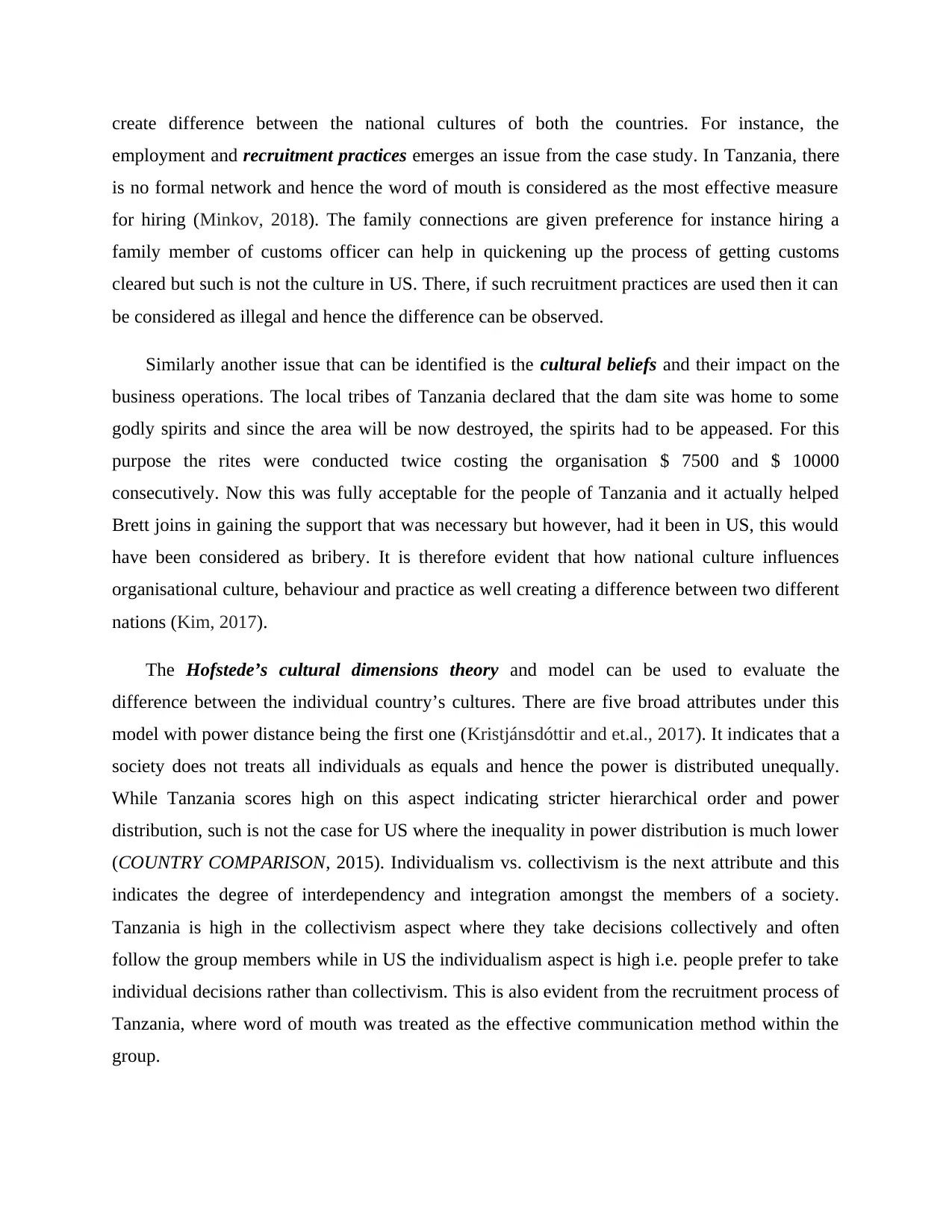
create difference between the national cultures of both the countries. For instance, the
employment and recruitment practices emerges an issue from the case study. In Tanzania, there
is no formal network and hence the word of mouth is considered as the most effective measure
for hiring (Minkov, 2018). The family connections are given preference for instance hiring a
family member of customs officer can help in quickening up the process of getting customs
cleared but such is not the culture in US. There, if such recruitment practices are used then it can
be considered as illegal and hence the difference can be observed.
Similarly another issue that can be identified is the cultural beliefs and their impact on the
business operations. The local tribes of Tanzania declared that the dam site was home to some
godly spirits and since the area will be now destroyed, the spirits had to be appeased. For this
purpose the rites were conducted twice costing the organisation $ 7500 and $ 10000
consecutively. Now this was fully acceptable for the people of Tanzania and it actually helped
Brett joins in gaining the support that was necessary but however, had it been in US, this would
have been considered as bribery. It is therefore evident that how national culture influences
organisational culture, behaviour and practice as well creating a difference between two different
nations (Kim, 2017).
The Hofstede’s cultural dimensions theory and model can be used to evaluate the
difference between the individual country’s cultures. There are five broad attributes under this
model with power distance being the first one (Kristjánsdóttir and et.al., 2017). It indicates that a
society does not treats all individuals as equals and hence the power is distributed unequally.
While Tanzania scores high on this aspect indicating stricter hierarchical order and power
distribution, such is not the case for US where the inequality in power distribution is much lower
(COUNTRY COMPARISON, 2015). Individualism vs. collectivism is the next attribute and this
indicates the degree of interdependency and integration amongst the members of a society.
Tanzania is high in the collectivism aspect where they take decisions collectively and often
follow the group members while in US the individualism aspect is high i.e. people prefer to take
individual decisions rather than collectivism. This is also evident from the recruitment process of
Tanzania, where word of mouth was treated as the effective communication method within the
group.
employment and recruitment practices emerges an issue from the case study. In Tanzania, there
is no formal network and hence the word of mouth is considered as the most effective measure
for hiring (Minkov, 2018). The family connections are given preference for instance hiring a
family member of customs officer can help in quickening up the process of getting customs
cleared but such is not the culture in US. There, if such recruitment practices are used then it can
be considered as illegal and hence the difference can be observed.
Similarly another issue that can be identified is the cultural beliefs and their impact on the
business operations. The local tribes of Tanzania declared that the dam site was home to some
godly spirits and since the area will be now destroyed, the spirits had to be appeased. For this
purpose the rites were conducted twice costing the organisation $ 7500 and $ 10000
consecutively. Now this was fully acceptable for the people of Tanzania and it actually helped
Brett joins in gaining the support that was necessary but however, had it been in US, this would
have been considered as bribery. It is therefore evident that how national culture influences
organisational culture, behaviour and practice as well creating a difference between two different
nations (Kim, 2017).
The Hofstede’s cultural dimensions theory and model can be used to evaluate the
difference between the individual country’s cultures. There are five broad attributes under this
model with power distance being the first one (Kristjánsdóttir and et.al., 2017). It indicates that a
society does not treats all individuals as equals and hence the power is distributed unequally.
While Tanzania scores high on this aspect indicating stricter hierarchical order and power
distribution, such is not the case for US where the inequality in power distribution is much lower
(COUNTRY COMPARISON, 2015). Individualism vs. collectivism is the next attribute and this
indicates the degree of interdependency and integration amongst the members of a society.
Tanzania is high in the collectivism aspect where they take decisions collectively and often
follow the group members while in US the individualism aspect is high i.e. people prefer to take
individual decisions rather than collectivism. This is also evident from the recruitment process of
Tanzania, where word of mouth was treated as the effective communication method within the
group.
Paraphrase This Document
Need a fresh take? Get an instant paraphrase of this document with our AI Paraphraser
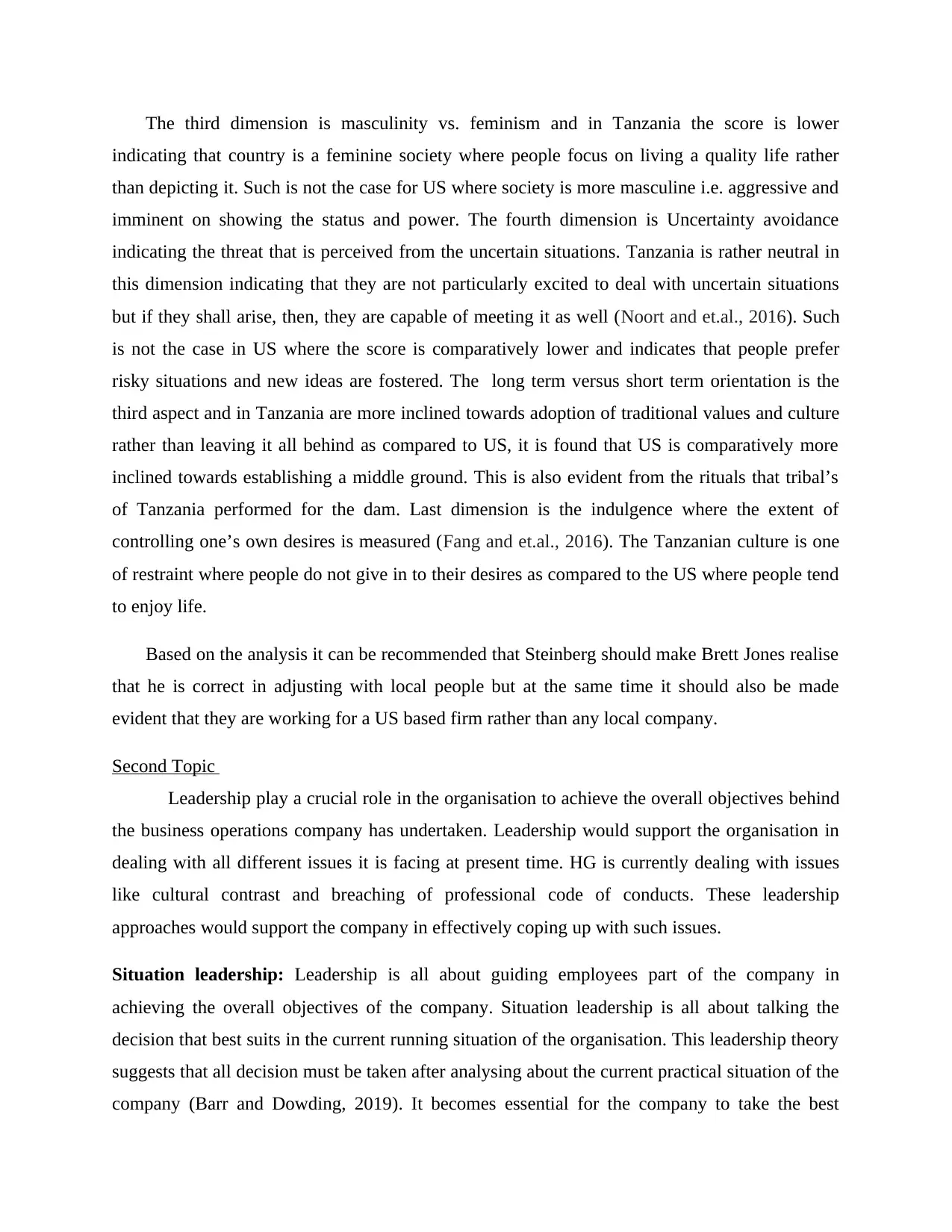
The third dimension is masculinity vs. feminism and in Tanzania the score is lower
indicating that country is a feminine society where people focus on living a quality life rather
than depicting it. Such is not the case for US where society is more masculine i.e. aggressive and
imminent on showing the status and power. The fourth dimension is Uncertainty avoidance
indicating the threat that is perceived from the uncertain situations. Tanzania is rather neutral in
this dimension indicating that they are not particularly excited to deal with uncertain situations
but if they shall arise, then, they are capable of meeting it as well (Noort and et.al., 2016). Such
is not the case in US where the score is comparatively lower and indicates that people prefer
risky situations and new ideas are fostered. The long term versus short term orientation is the
third aspect and in Tanzania are more inclined towards adoption of traditional values and culture
rather than leaving it all behind as compared to US, it is found that US is comparatively more
inclined towards establishing a middle ground. This is also evident from the rituals that tribal’s
of Tanzania performed for the dam. Last dimension is the indulgence where the extent of
controlling one’s own desires is measured (Fang and et.al., 2016). The Tanzanian culture is one
of restraint where people do not give in to their desires as compared to the US where people tend
to enjoy life.
Based on the analysis it can be recommended that Steinberg should make Brett Jones realise
that he is correct in adjusting with local people but at the same time it should also be made
evident that they are working for a US based firm rather than any local company.
Second Topic
Leadership play a crucial role in the organisation to achieve the overall objectives behind
the business operations company has undertaken. Leadership would support the organisation in
dealing with all different issues it is facing at present time. HG is currently dealing with issues
like cultural contrast and breaching of professional code of conducts. These leadership
approaches would support the company in effectively coping up with such issues.
Situation leadership: Leadership is all about guiding employees part of the company in
achieving the overall objectives of the company. Situation leadership is all about talking the
decision that best suits in the current running situation of the organisation. This leadership theory
suggests that all decision must be taken after analysing about the current practical situation of the
company (Barr and Dowding, 2019). It becomes essential for the company to take the best
indicating that country is a feminine society where people focus on living a quality life rather
than depicting it. Such is not the case for US where society is more masculine i.e. aggressive and
imminent on showing the status and power. The fourth dimension is Uncertainty avoidance
indicating the threat that is perceived from the uncertain situations. Tanzania is rather neutral in
this dimension indicating that they are not particularly excited to deal with uncertain situations
but if they shall arise, then, they are capable of meeting it as well (Noort and et.al., 2016). Such
is not the case in US where the score is comparatively lower and indicates that people prefer
risky situations and new ideas are fostered. The long term versus short term orientation is the
third aspect and in Tanzania are more inclined towards adoption of traditional values and culture
rather than leaving it all behind as compared to US, it is found that US is comparatively more
inclined towards establishing a middle ground. This is also evident from the rituals that tribal’s
of Tanzania performed for the dam. Last dimension is the indulgence where the extent of
controlling one’s own desires is measured (Fang and et.al., 2016). The Tanzanian culture is one
of restraint where people do not give in to their desires as compared to the US where people tend
to enjoy life.
Based on the analysis it can be recommended that Steinberg should make Brett Jones realise
that he is correct in adjusting with local people but at the same time it should also be made
evident that they are working for a US based firm rather than any local company.
Second Topic
Leadership play a crucial role in the organisation to achieve the overall objectives behind
the business operations company has undertaken. Leadership would support the organisation in
dealing with all different issues it is facing at present time. HG is currently dealing with issues
like cultural contrast and breaching of professional code of conducts. These leadership
approaches would support the company in effectively coping up with such issues.
Situation leadership: Leadership is all about guiding employees part of the company in
achieving the overall objectives of the company. Situation leadership is all about talking the
decision that best suits in the current running situation of the organisation. This leadership theory
suggests that all decision must be taken after analysing about the current practical situation of the
company (Barr and Dowding, 2019). It becomes essential for the company to take the best
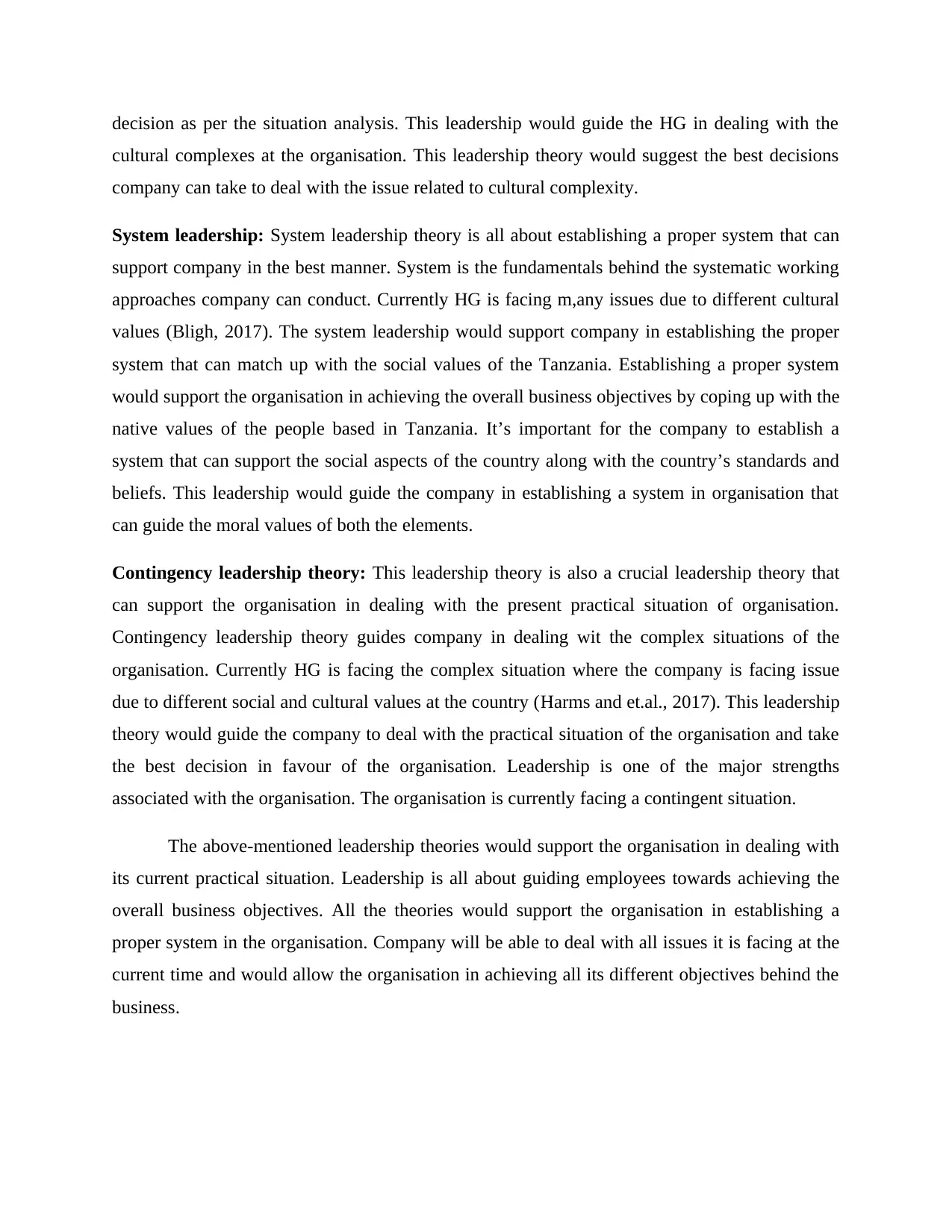
decision as per the situation analysis. This leadership would guide the HG in dealing with the
cultural complexes at the organisation. This leadership theory would suggest the best decisions
company can take to deal with the issue related to cultural complexity.
System leadership: System leadership theory is all about establishing a proper system that can
support company in the best manner. System is the fundamentals behind the systematic working
approaches company can conduct. Currently HG is facing m,any issues due to different cultural
values (Bligh, 2017). The system leadership would support company in establishing the proper
system that can match up with the social values of the Tanzania. Establishing a proper system
would support the organisation in achieving the overall business objectives by coping up with the
native values of the people based in Tanzania. It’s important for the company to establish a
system that can support the social aspects of the country along with the country’s standards and
beliefs. This leadership would guide the company in establishing a system in organisation that
can guide the moral values of both the elements.
Contingency leadership theory: This leadership theory is also a crucial leadership theory that
can support the organisation in dealing with the present practical situation of organisation.
Contingency leadership theory guides company in dealing wit the complex situations of the
organisation. Currently HG is facing the complex situation where the company is facing issue
due to different social and cultural values at the country (Harms and et.al., 2017). This leadership
theory would guide the company to deal with the practical situation of the organisation and take
the best decision in favour of the organisation. Leadership is one of the major strengths
associated with the organisation. The organisation is currently facing a contingent situation.
The above-mentioned leadership theories would support the organisation in dealing with
its current practical situation. Leadership is all about guiding employees towards achieving the
overall business objectives. All the theories would support the organisation in establishing a
proper system in the organisation. Company will be able to deal with all issues it is facing at the
current time and would allow the organisation in achieving all its different objectives behind the
business.
cultural complexes at the organisation. This leadership theory would suggest the best decisions
company can take to deal with the issue related to cultural complexity.
System leadership: System leadership theory is all about establishing a proper system that can
support company in the best manner. System is the fundamentals behind the systematic working
approaches company can conduct. Currently HG is facing m,any issues due to different cultural
values (Bligh, 2017). The system leadership would support company in establishing the proper
system that can match up with the social values of the Tanzania. Establishing a proper system
would support the organisation in achieving the overall business objectives by coping up with the
native values of the people based in Tanzania. It’s important for the company to establish a
system that can support the social aspects of the country along with the country’s standards and
beliefs. This leadership would guide the company in establishing a system in organisation that
can guide the moral values of both the elements.
Contingency leadership theory: This leadership theory is also a crucial leadership theory that
can support the organisation in dealing with the present practical situation of organisation.
Contingency leadership theory guides company in dealing wit the complex situations of the
organisation. Currently HG is facing the complex situation where the company is facing issue
due to different social and cultural values at the country (Harms and et.al., 2017). This leadership
theory would guide the company to deal with the practical situation of the organisation and take
the best decision in favour of the organisation. Leadership is one of the major strengths
associated with the organisation. The organisation is currently facing a contingent situation.
The above-mentioned leadership theories would support the organisation in dealing with
its current practical situation. Leadership is all about guiding employees towards achieving the
overall business objectives. All the theories would support the organisation in establishing a
proper system in the organisation. Company will be able to deal with all issues it is facing at the
current time and would allow the organisation in achieving all its different objectives behind the
business.
⊘ This is a preview!⊘
Do you want full access?
Subscribe today to unlock all pages.

Trusted by 1+ million students worldwide
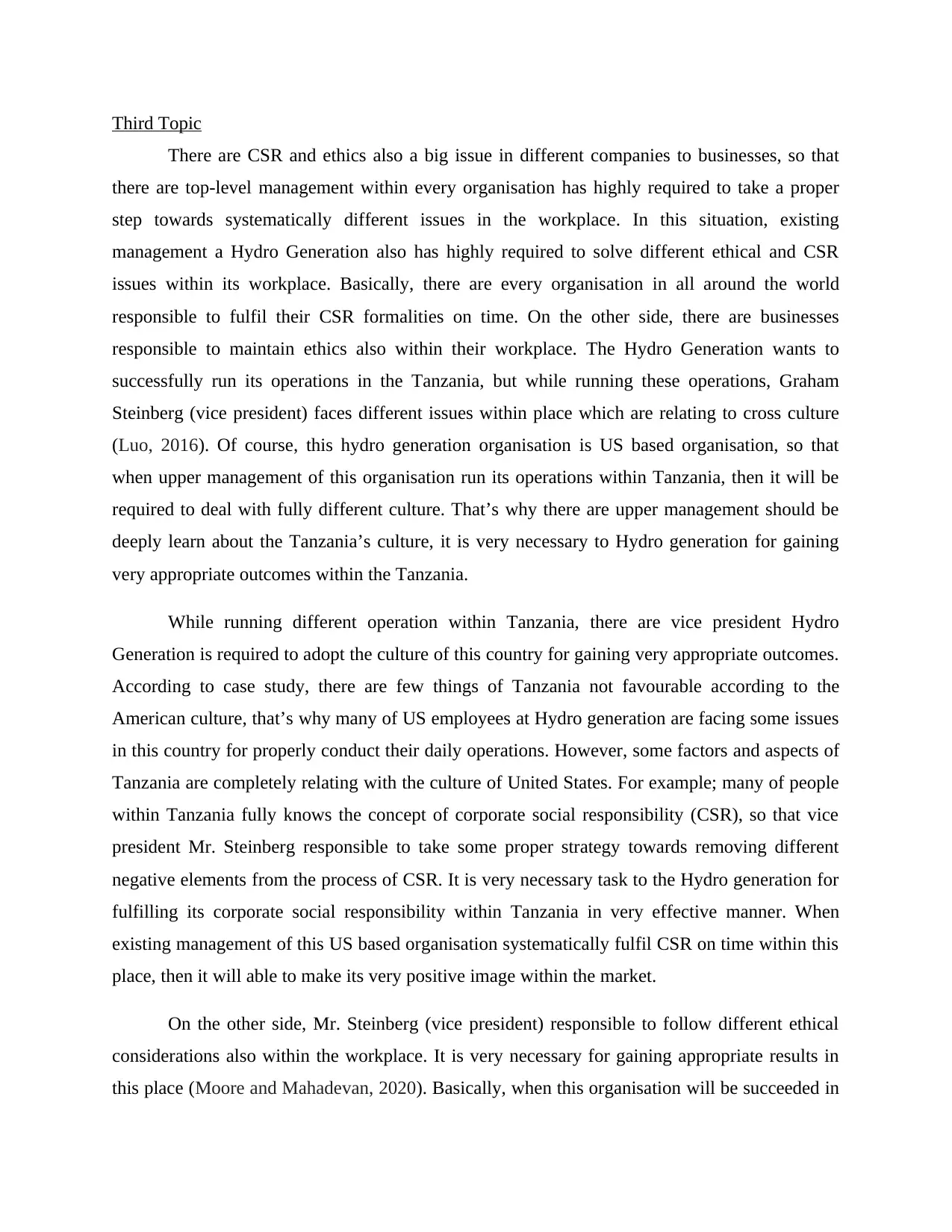
Third Topic
There are CSR and ethics also a big issue in different companies to businesses, so that
there are top-level management within every organisation has highly required to take a proper
step towards systematically different issues in the workplace. In this situation, existing
management a Hydro Generation also has highly required to solve different ethical and CSR
issues within its workplace. Basically, there are every organisation in all around the world
responsible to fulfil their CSR formalities on time. On the other side, there are businesses
responsible to maintain ethics also within their workplace. The Hydro Generation wants to
successfully run its operations in the Tanzania, but while running these operations, Graham
Steinberg (vice president) faces different issues within place which are relating to cross culture
(Luo, 2016). Of course, this hydro generation organisation is US based organisation, so that
when upper management of this organisation run its operations within Tanzania, then it will be
required to deal with fully different culture. That’s why there are upper management should be
deeply learn about the Tanzania’s culture, it is very necessary to Hydro generation for gaining
very appropriate outcomes within the Tanzania.
While running different operation within Tanzania, there are vice president Hydro
Generation is required to adopt the culture of this country for gaining very appropriate outcomes.
According to case study, there are few things of Tanzania not favourable according to the
American culture, that’s why many of US employees at Hydro generation are facing some issues
in this country for properly conduct their daily operations. However, some factors and aspects of
Tanzania are completely relating with the culture of United States. For example; many of people
within Tanzania fully knows the concept of corporate social responsibility (CSR), so that vice
president Mr. Steinberg responsible to take some proper strategy towards removing different
negative elements from the process of CSR. It is very necessary task to the Hydro generation for
fulfilling its corporate social responsibility within Tanzania in very effective manner. When
existing management of this US based organisation systematically fulfil CSR on time within this
place, then it will able to make its very positive image within the market.
On the other side, Mr. Steinberg (vice president) responsible to follow different ethical
considerations also within the workplace. It is very necessary for gaining appropriate results in
this place (Moore and Mahadevan, 2020). Basically, when this organisation will be succeeded in
There are CSR and ethics also a big issue in different companies to businesses, so that
there are top-level management within every organisation has highly required to take a proper
step towards systematically different issues in the workplace. In this situation, existing
management a Hydro Generation also has highly required to solve different ethical and CSR
issues within its workplace. Basically, there are every organisation in all around the world
responsible to fulfil their CSR formalities on time. On the other side, there are businesses
responsible to maintain ethics also within their workplace. The Hydro Generation wants to
successfully run its operations in the Tanzania, but while running these operations, Graham
Steinberg (vice president) faces different issues within place which are relating to cross culture
(Luo, 2016). Of course, this hydro generation organisation is US based organisation, so that
when upper management of this organisation run its operations within Tanzania, then it will be
required to deal with fully different culture. That’s why there are upper management should be
deeply learn about the Tanzania’s culture, it is very necessary to Hydro generation for gaining
very appropriate outcomes within the Tanzania.
While running different operation within Tanzania, there are vice president Hydro
Generation is required to adopt the culture of this country for gaining very appropriate outcomes.
According to case study, there are few things of Tanzania not favourable according to the
American culture, that’s why many of US employees at Hydro generation are facing some issues
in this country for properly conduct their daily operations. However, some factors and aspects of
Tanzania are completely relating with the culture of United States. For example; many of people
within Tanzania fully knows the concept of corporate social responsibility (CSR), so that vice
president Mr. Steinberg responsible to take some proper strategy towards removing different
negative elements from the process of CSR. It is very necessary task to the Hydro generation for
fulfilling its corporate social responsibility within Tanzania in very effective manner. When
existing management of this US based organisation systematically fulfil CSR on time within this
place, then it will able to make its very positive image within the market.
On the other side, Mr. Steinberg (vice president) responsible to follow different ethical
considerations also within the workplace. It is very necessary for gaining appropriate results in
this place (Moore and Mahadevan, 2020). Basically, when this organisation will be succeeded in
Paraphrase This Document
Need a fresh take? Get an instant paraphrase of this document with our AI Paraphraser
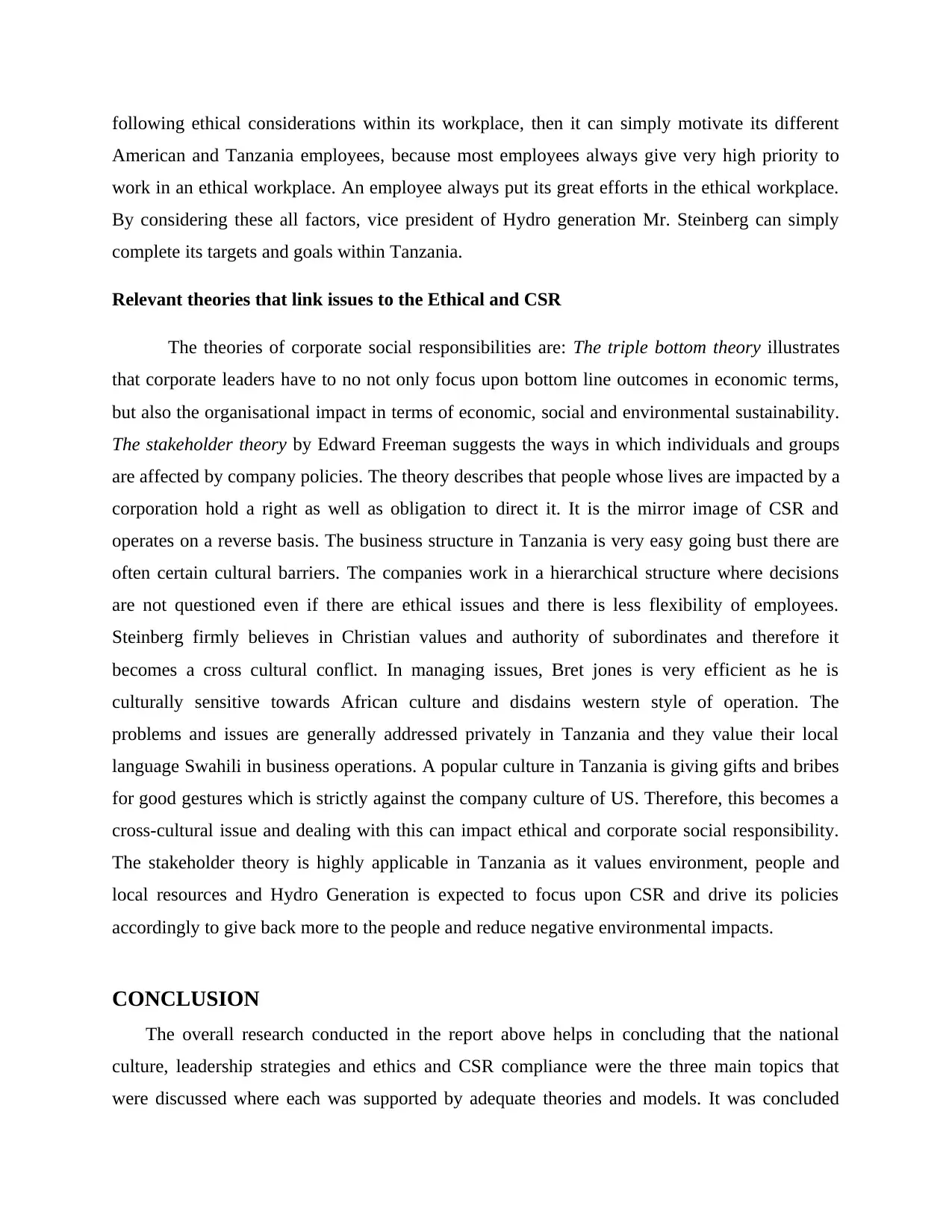
following ethical considerations within its workplace, then it can simply motivate its different
American and Tanzania employees, because most employees always give very high priority to
work in an ethical workplace. An employee always put its great efforts in the ethical workplace.
By considering these all factors, vice president of Hydro generation Mr. Steinberg can simply
complete its targets and goals within Tanzania.
Relevant theories that link issues to the Ethical and CSR
The theories of corporate social responsibilities are: The triple bottom theory illustrates
that corporate leaders have to no not only focus upon bottom line outcomes in economic terms,
but also the organisational impact in terms of economic, social and environmental sustainability.
The stakeholder theory by Edward Freeman suggests the ways in which individuals and groups
are affected by company policies. The theory describes that people whose lives are impacted by a
corporation hold a right as well as obligation to direct it. It is the mirror image of CSR and
operates on a reverse basis. The business structure in Tanzania is very easy going bust there are
often certain cultural barriers. The companies work in a hierarchical structure where decisions
are not questioned even if there are ethical issues and there is less flexibility of employees.
Steinberg firmly believes in Christian values and authority of subordinates and therefore it
becomes a cross cultural conflict. In managing issues, Bret jones is very efficient as he is
culturally sensitive towards African culture and disdains western style of operation. The
problems and issues are generally addressed privately in Tanzania and they value their local
language Swahili in business operations. A popular culture in Tanzania is giving gifts and bribes
for good gestures which is strictly against the company culture of US. Therefore, this becomes a
cross-cultural issue and dealing with this can impact ethical and corporate social responsibility.
The stakeholder theory is highly applicable in Tanzania as it values environment, people and
local resources and Hydro Generation is expected to focus upon CSR and drive its policies
accordingly to give back more to the people and reduce negative environmental impacts.
CONCLUSION
The overall research conducted in the report above helps in concluding that the national
culture, leadership strategies and ethics and CSR compliance were the three main topics that
were discussed where each was supported by adequate theories and models. It was concluded
American and Tanzania employees, because most employees always give very high priority to
work in an ethical workplace. An employee always put its great efforts in the ethical workplace.
By considering these all factors, vice president of Hydro generation Mr. Steinberg can simply
complete its targets and goals within Tanzania.
Relevant theories that link issues to the Ethical and CSR
The theories of corporate social responsibilities are: The triple bottom theory illustrates
that corporate leaders have to no not only focus upon bottom line outcomes in economic terms,
but also the organisational impact in terms of economic, social and environmental sustainability.
The stakeholder theory by Edward Freeman suggests the ways in which individuals and groups
are affected by company policies. The theory describes that people whose lives are impacted by a
corporation hold a right as well as obligation to direct it. It is the mirror image of CSR and
operates on a reverse basis. The business structure in Tanzania is very easy going bust there are
often certain cultural barriers. The companies work in a hierarchical structure where decisions
are not questioned even if there are ethical issues and there is less flexibility of employees.
Steinberg firmly believes in Christian values and authority of subordinates and therefore it
becomes a cross cultural conflict. In managing issues, Bret jones is very efficient as he is
culturally sensitive towards African culture and disdains western style of operation. The
problems and issues are generally addressed privately in Tanzania and they value their local
language Swahili in business operations. A popular culture in Tanzania is giving gifts and bribes
for good gestures which is strictly against the company culture of US. Therefore, this becomes a
cross-cultural issue and dealing with this can impact ethical and corporate social responsibility.
The stakeholder theory is highly applicable in Tanzania as it values environment, people and
local resources and Hydro Generation is expected to focus upon CSR and drive its policies
accordingly to give back more to the people and reduce negative environmental impacts.
CONCLUSION
The overall research conducted in the report above helps in concluding that the national
culture, leadership strategies and ethics and CSR compliance were the three main topics that
were discussed where each was supported by adequate theories and models. It was concluded
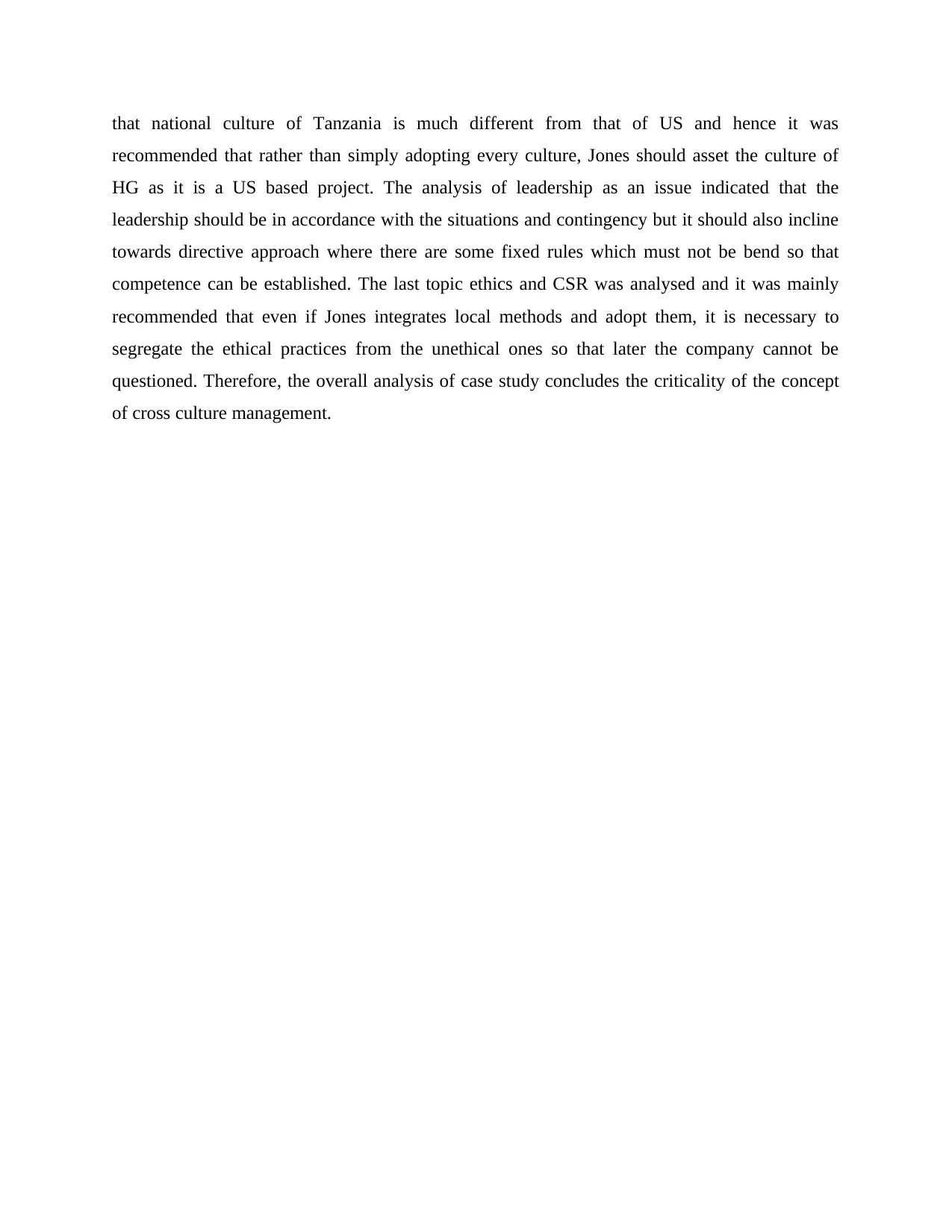
that national culture of Tanzania is much different from that of US and hence it was
recommended that rather than simply adopting every culture, Jones should asset the culture of
HG as it is a US based project. The analysis of leadership as an issue indicated that the
leadership should be in accordance with the situations and contingency but it should also incline
towards directive approach where there are some fixed rules which must not be bend so that
competence can be established. The last topic ethics and CSR was analysed and it was mainly
recommended that even if Jones integrates local methods and adopt them, it is necessary to
segregate the ethical practices from the unethical ones so that later the company cannot be
questioned. Therefore, the overall analysis of case study concludes the criticality of the concept
of cross culture management.
recommended that rather than simply adopting every culture, Jones should asset the culture of
HG as it is a US based project. The analysis of leadership as an issue indicated that the
leadership should be in accordance with the situations and contingency but it should also incline
towards directive approach where there are some fixed rules which must not be bend so that
competence can be established. The last topic ethics and CSR was analysed and it was mainly
recommended that even if Jones integrates local methods and adopt them, it is necessary to
segregate the ethical practices from the unethical ones so that later the company cannot be
questioned. Therefore, the overall analysis of case study concludes the criticality of the concept
of cross culture management.
⊘ This is a preview!⊘
Do you want full access?
Subscribe today to unlock all pages.

Trusted by 1+ million students worldwide
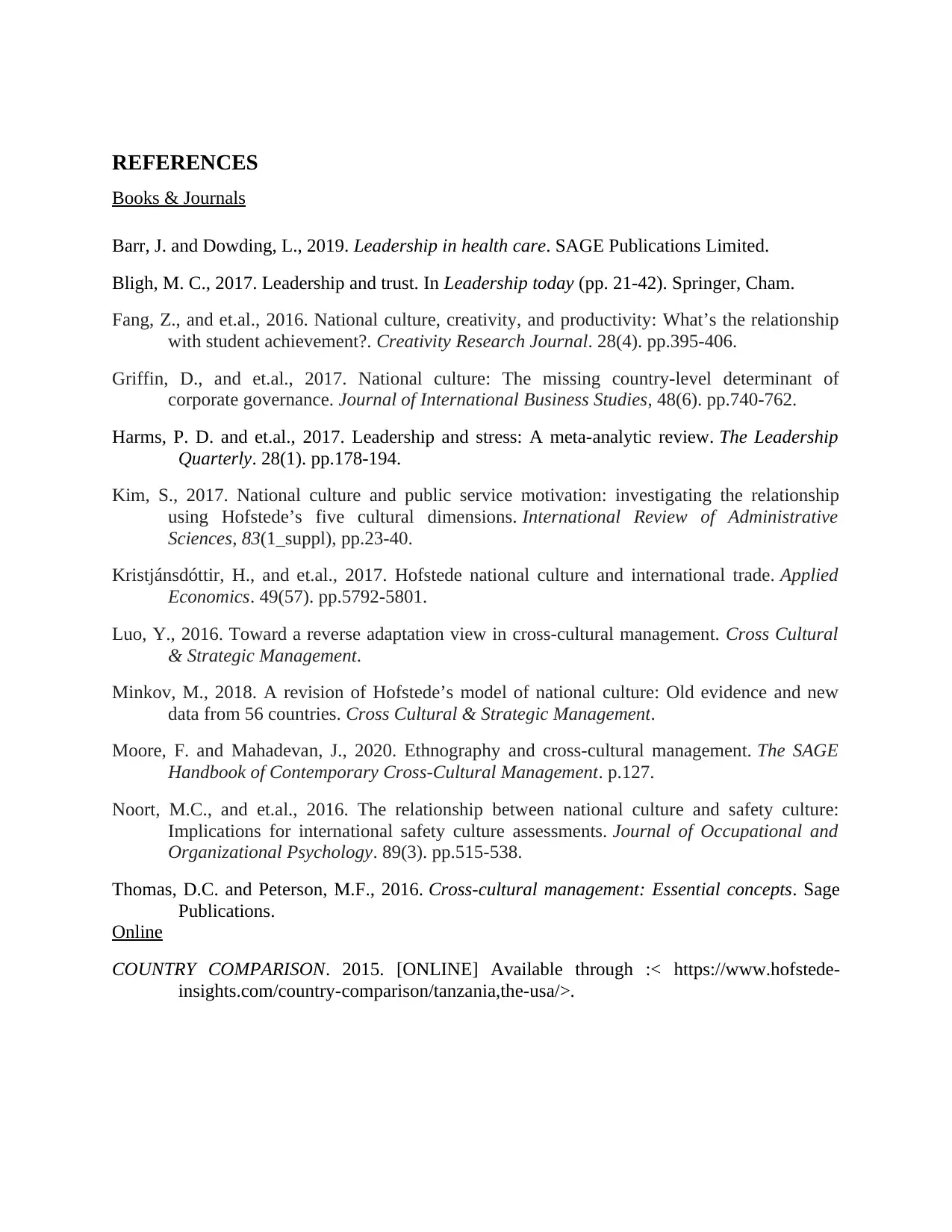
REFERENCES
Books & Journals
Barr, J. and Dowding, L., 2019. Leadership in health care. SAGE Publications Limited.
Bligh, M. C., 2017. Leadership and trust. In Leadership today (pp. 21-42). Springer, Cham.
Fang, Z., and et.al., 2016. National culture, creativity, and productivity: What’s the relationship
with student achievement?. Creativity Research Journal. 28(4). pp.395-406.
Griffin, D., and et.al., 2017. National culture: The missing country-level determinant of
corporate governance. Journal of International Business Studies, 48(6). pp.740-762.
Harms, P. D. and et.al., 2017. Leadership and stress: A meta-analytic review. The Leadership
Quarterly. 28(1). pp.178-194.
Kim, S., 2017. National culture and public service motivation: investigating the relationship
using Hofstede’s five cultural dimensions. International Review of Administrative
Sciences, 83(1_suppl), pp.23-40.
Kristjánsdóttir, H., and et.al., 2017. Hofstede national culture and international trade. Applied
Economics. 49(57). pp.5792-5801.
Luo, Y., 2016. Toward a reverse adaptation view in cross-cultural management. Cross Cultural
& Strategic Management.
Minkov, M., 2018. A revision of Hofstede’s model of national culture: Old evidence and new
data from 56 countries. Cross Cultural & Strategic Management.
Moore, F. and Mahadevan, J., 2020. Ethnography and cross-cultural management. The SAGE
Handbook of Contemporary Cross-Cultural Management. p.127.
Noort, M.C., and et.al., 2016. The relationship between national culture and safety culture:
Implications for international safety culture assessments. Journal of Occupational and
Organizational Psychology. 89(3). pp.515-538.
Thomas, D.C. and Peterson, M.F., 2016. Cross-cultural management: Essential concepts. Sage
Publications.
Online
COUNTRY COMPARISON. 2015. [ONLINE] Available through :< https://www.hofstede-
insights.com/country-comparison/tanzania,the-usa/>.
Books & Journals
Barr, J. and Dowding, L., 2019. Leadership in health care. SAGE Publications Limited.
Bligh, M. C., 2017. Leadership and trust. In Leadership today (pp. 21-42). Springer, Cham.
Fang, Z., and et.al., 2016. National culture, creativity, and productivity: What’s the relationship
with student achievement?. Creativity Research Journal. 28(4). pp.395-406.
Griffin, D., and et.al., 2017. National culture: The missing country-level determinant of
corporate governance. Journal of International Business Studies, 48(6). pp.740-762.
Harms, P. D. and et.al., 2017. Leadership and stress: A meta-analytic review. The Leadership
Quarterly. 28(1). pp.178-194.
Kim, S., 2017. National culture and public service motivation: investigating the relationship
using Hofstede’s five cultural dimensions. International Review of Administrative
Sciences, 83(1_suppl), pp.23-40.
Kristjánsdóttir, H., and et.al., 2017. Hofstede national culture and international trade. Applied
Economics. 49(57). pp.5792-5801.
Luo, Y., 2016. Toward a reverse adaptation view in cross-cultural management. Cross Cultural
& Strategic Management.
Minkov, M., 2018. A revision of Hofstede’s model of national culture: Old evidence and new
data from 56 countries. Cross Cultural & Strategic Management.
Moore, F. and Mahadevan, J., 2020. Ethnography and cross-cultural management. The SAGE
Handbook of Contemporary Cross-Cultural Management. p.127.
Noort, M.C., and et.al., 2016. The relationship between national culture and safety culture:
Implications for international safety culture assessments. Journal of Occupational and
Organizational Psychology. 89(3). pp.515-538.
Thomas, D.C. and Peterson, M.F., 2016. Cross-cultural management: Essential concepts. Sage
Publications.
Online
COUNTRY COMPARISON. 2015. [ONLINE] Available through :< https://www.hofstede-
insights.com/country-comparison/tanzania,the-usa/>.
Paraphrase This Document
Need a fresh take? Get an instant paraphrase of this document with our AI Paraphraser
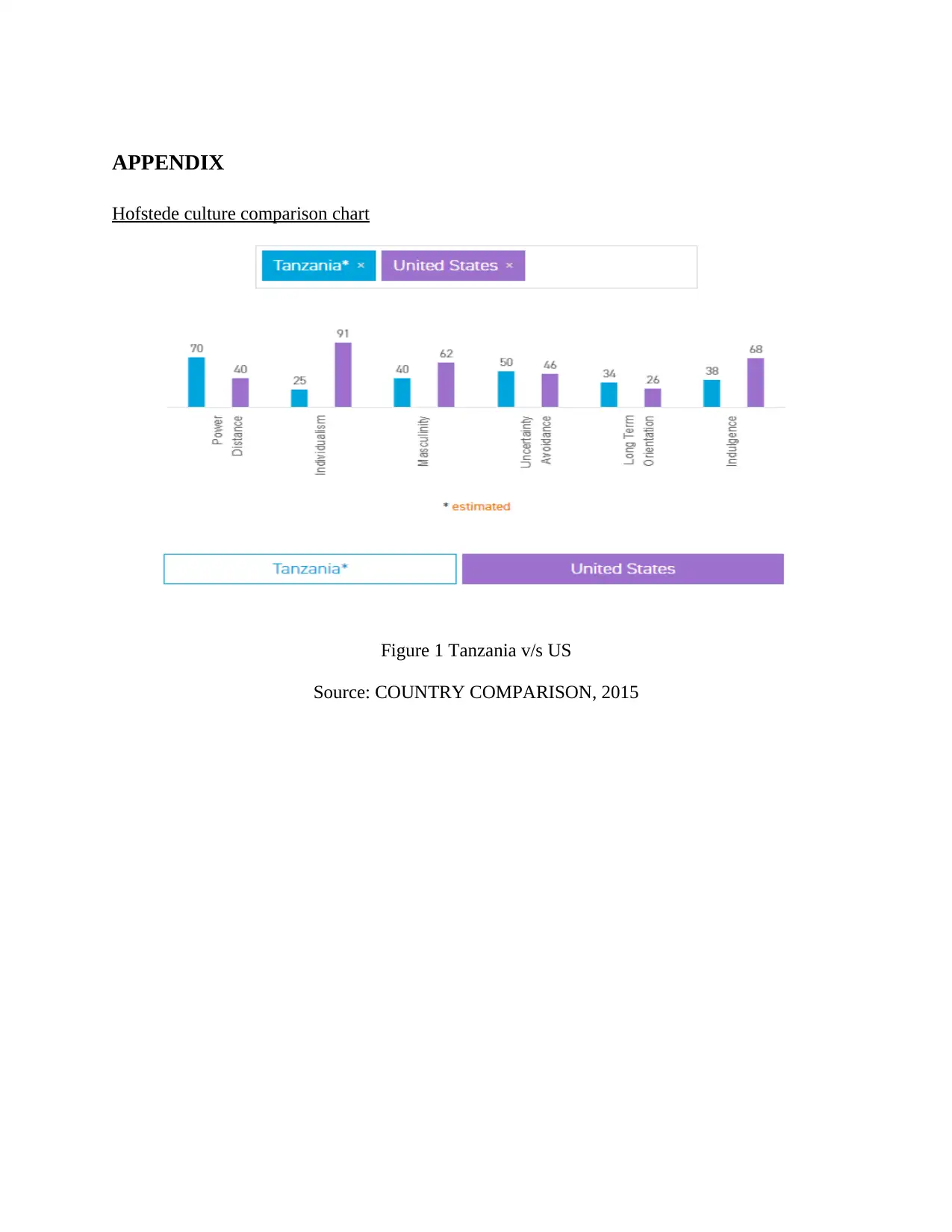
APPENDIX
Hofstede culture comparison chart
Figure 1 Tanzania v/s US
Source: COUNTRY COMPARISON, 2015
Hofstede culture comparison chart
Figure 1 Tanzania v/s US
Source: COUNTRY COMPARISON, 2015
1 out of 11
Related Documents
Your All-in-One AI-Powered Toolkit for Academic Success.
+13062052269
info@desklib.com
Available 24*7 on WhatsApp / Email
![[object Object]](/_next/static/media/star-bottom.7253800d.svg)
Unlock your academic potential
Copyright © 2020–2025 A2Z Services. All Rights Reserved. Developed and managed by ZUCOL.




